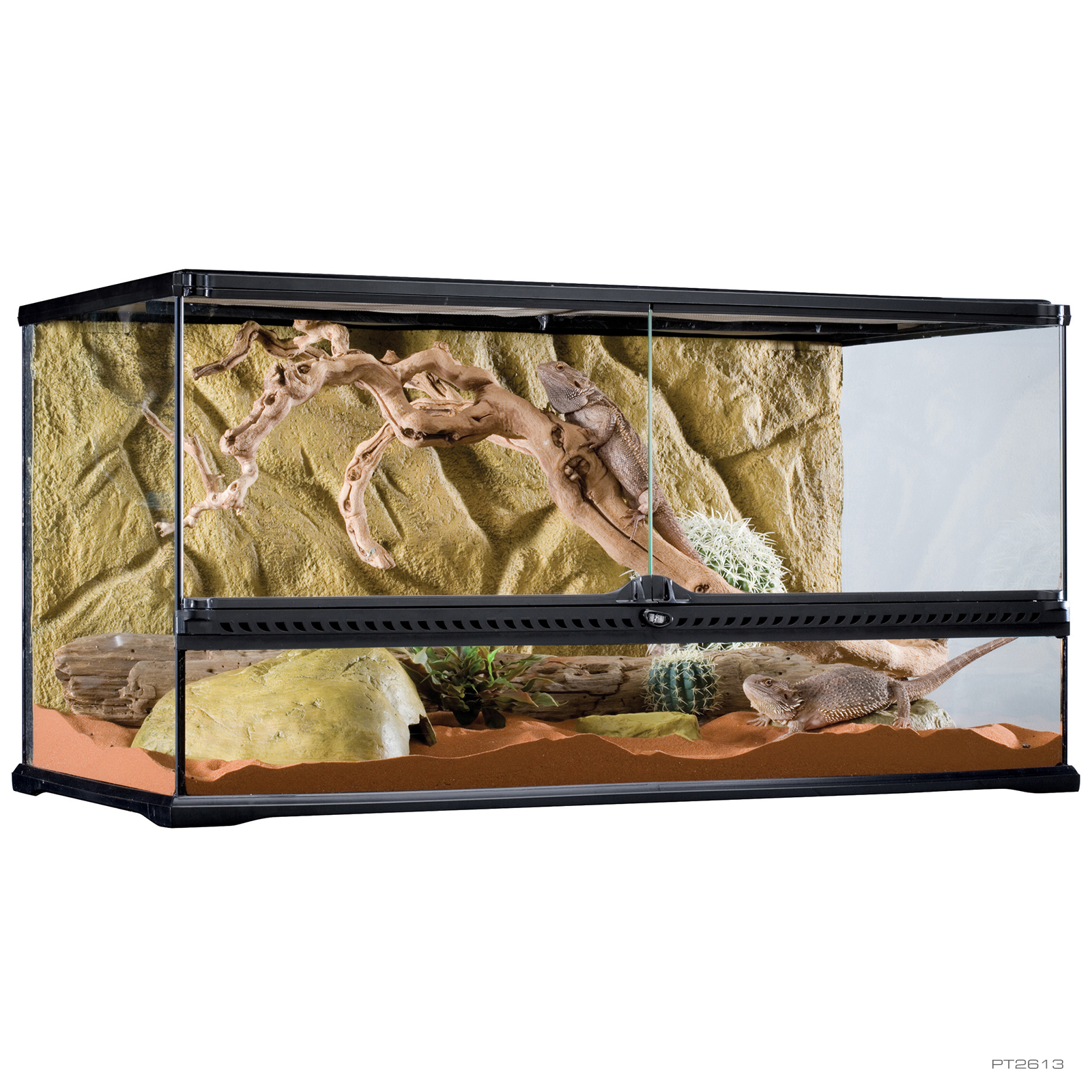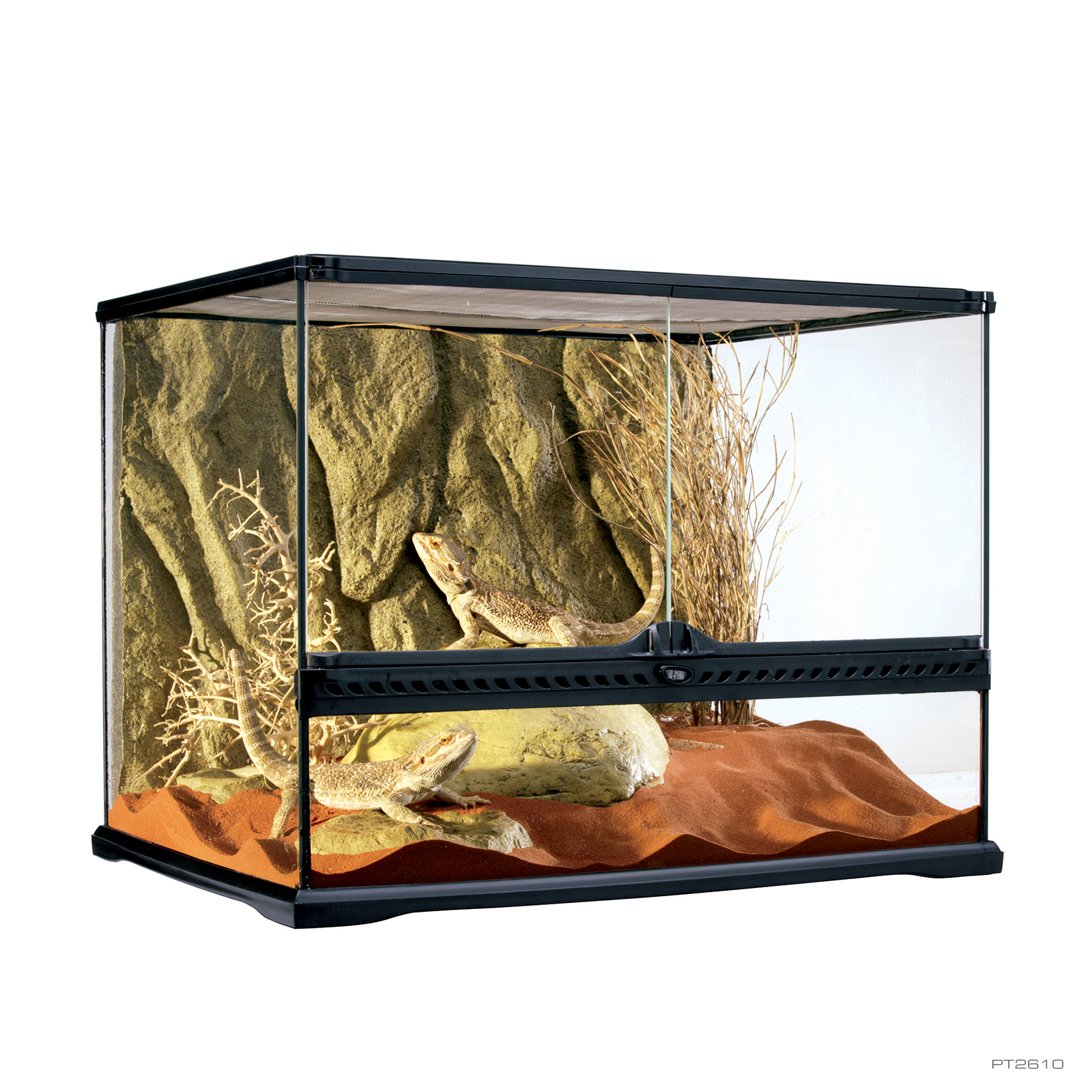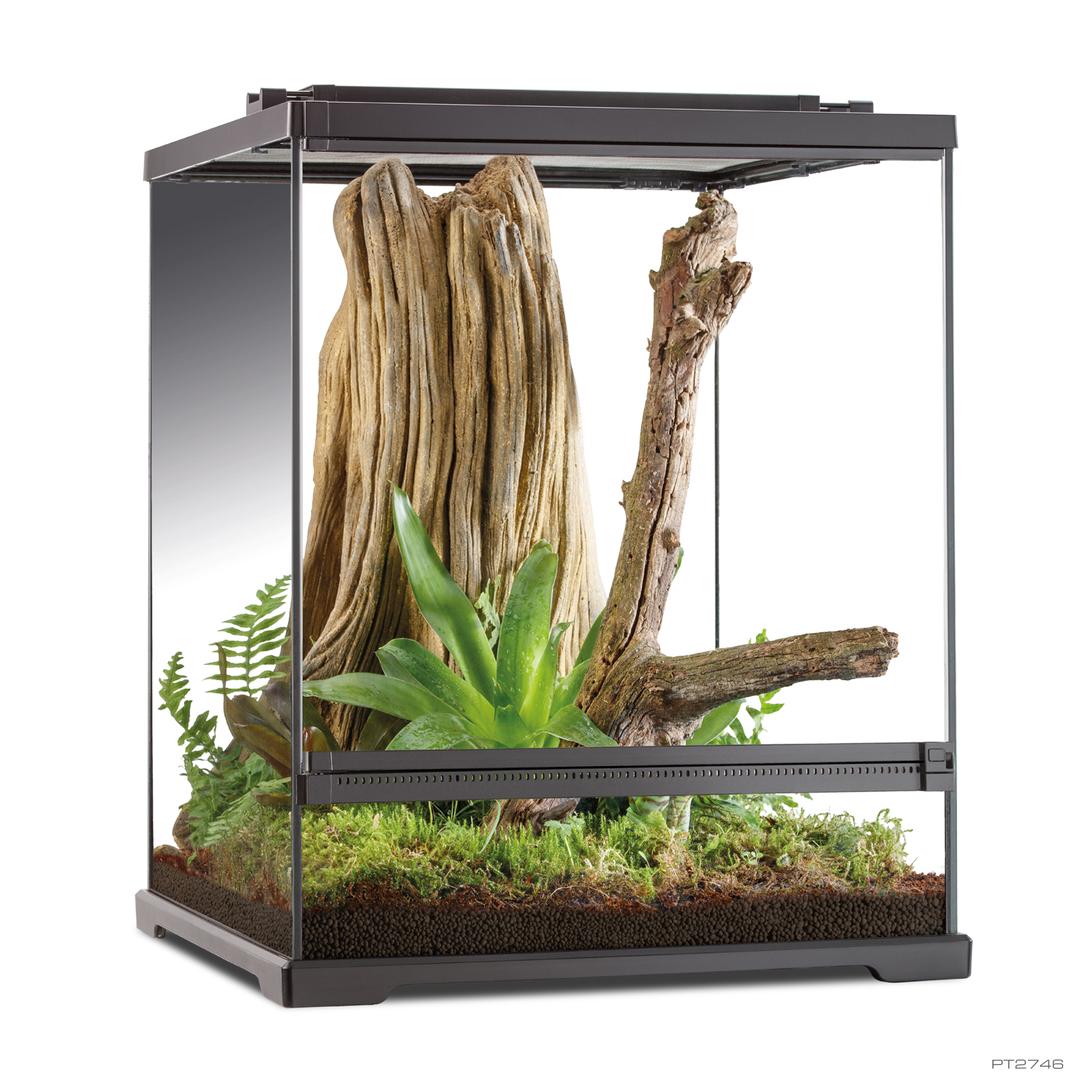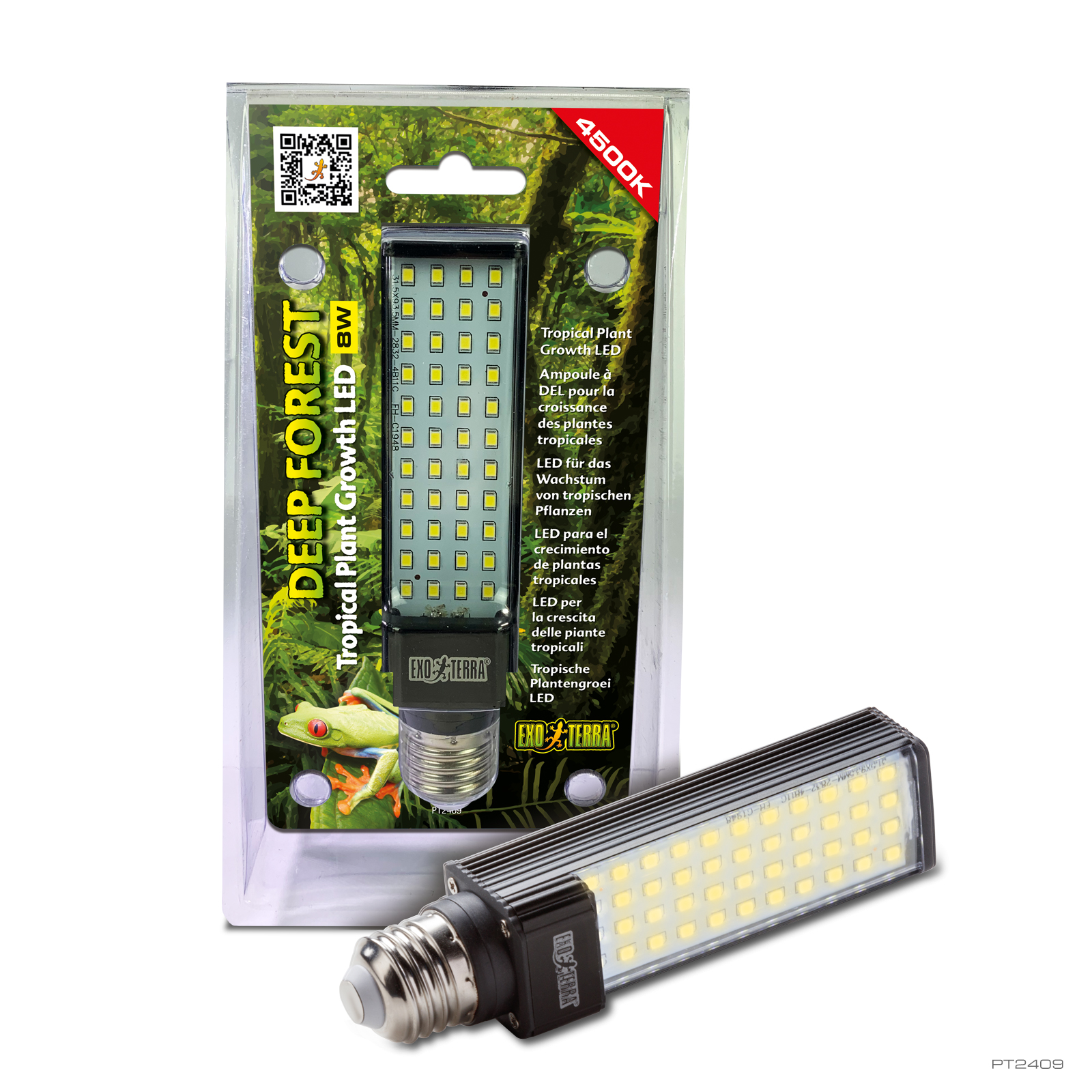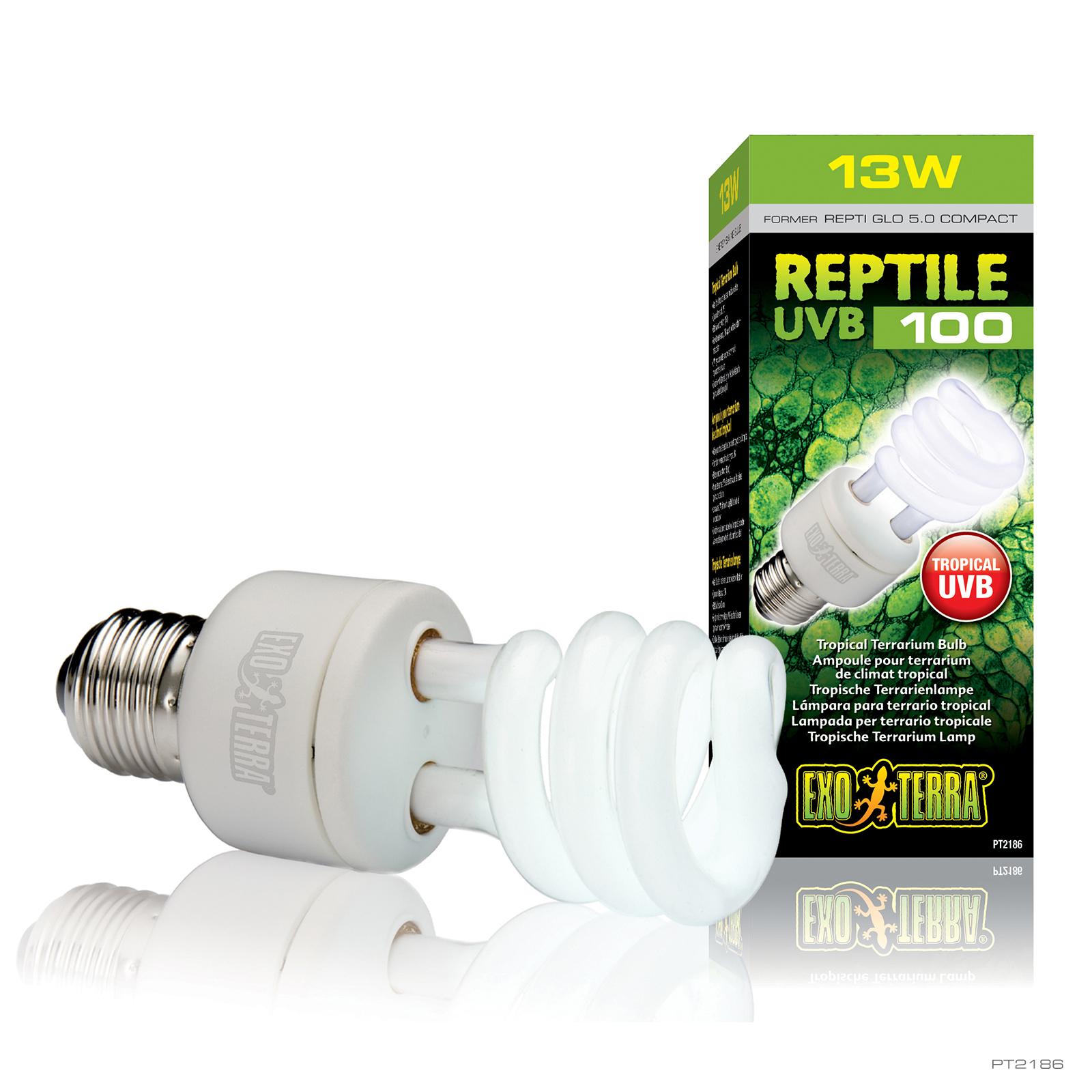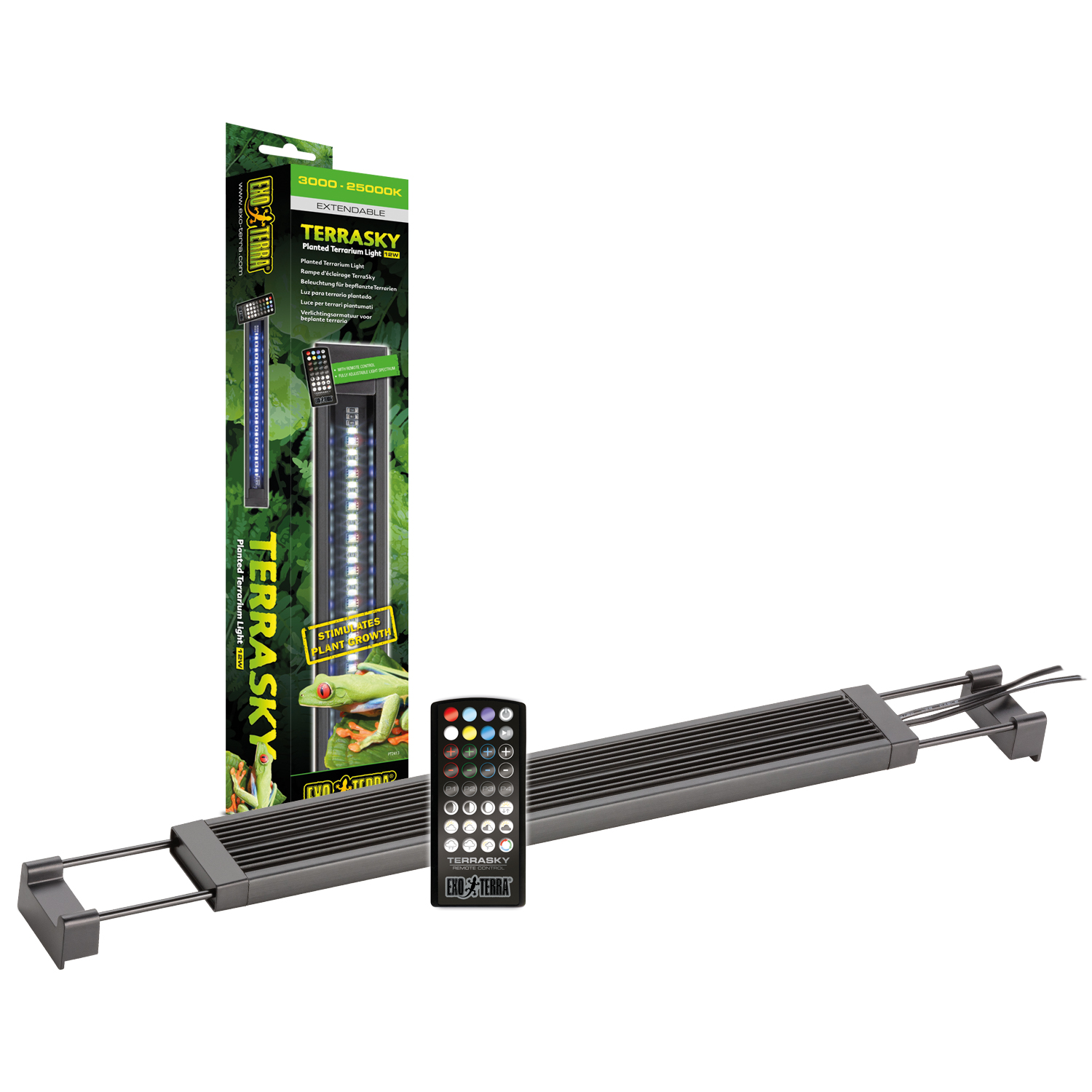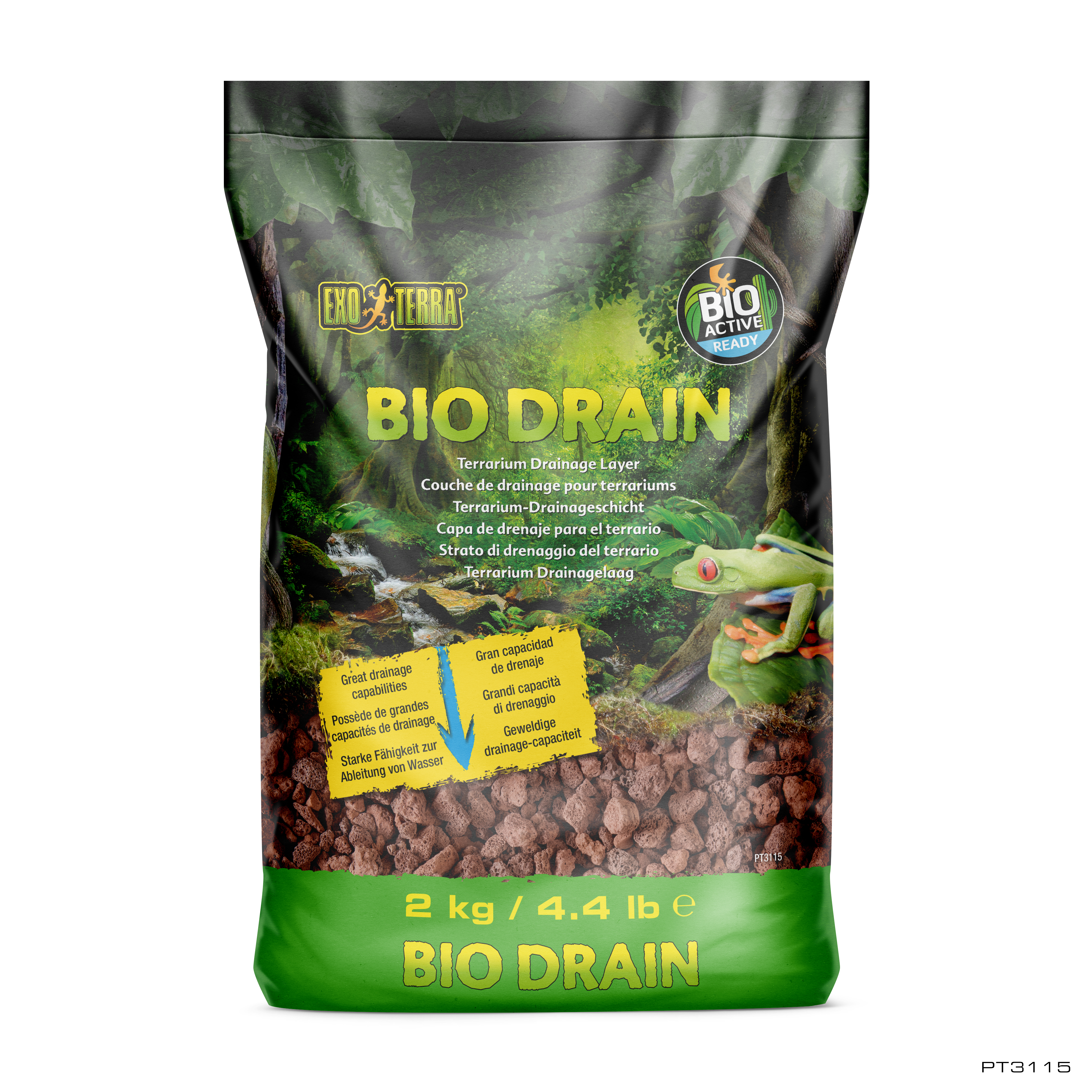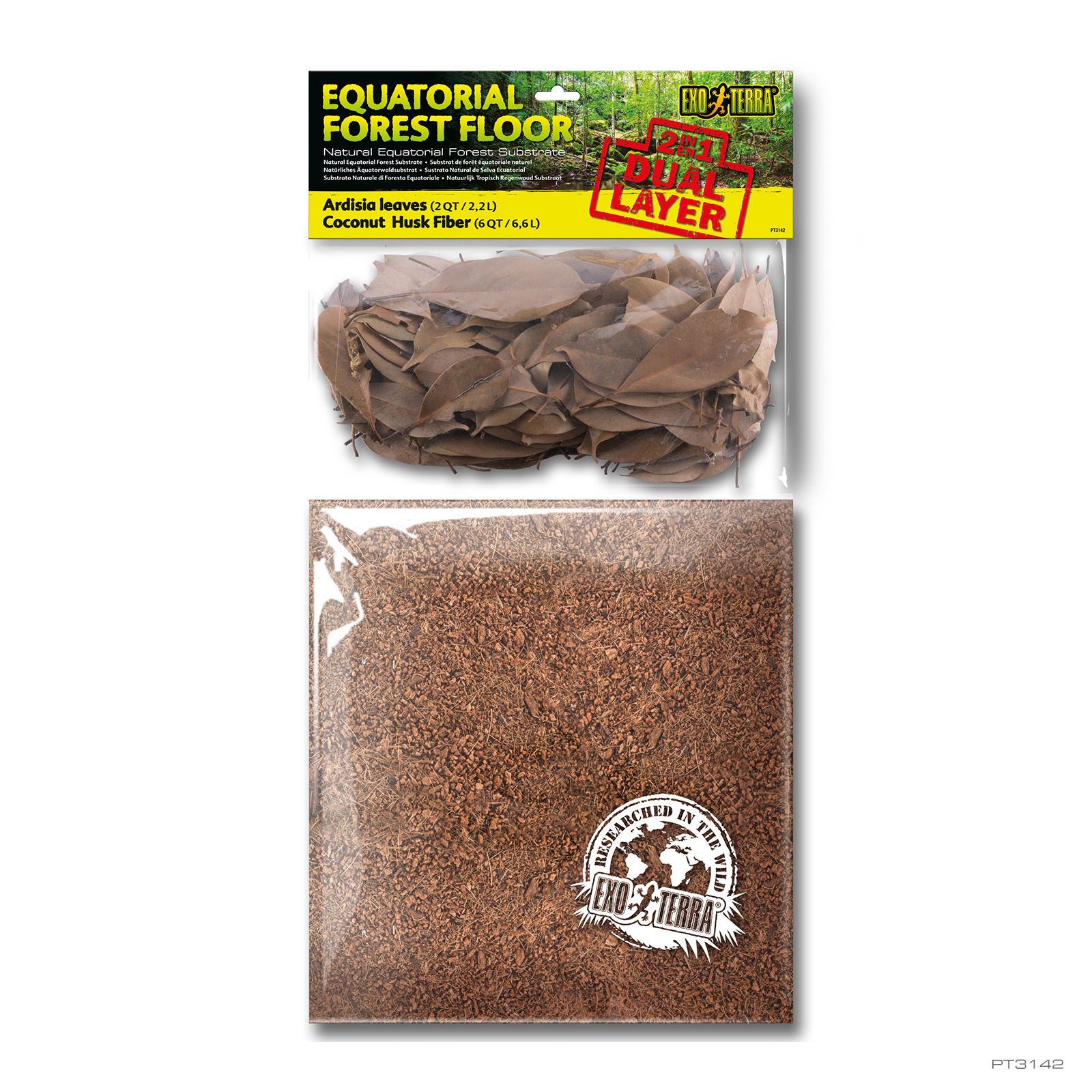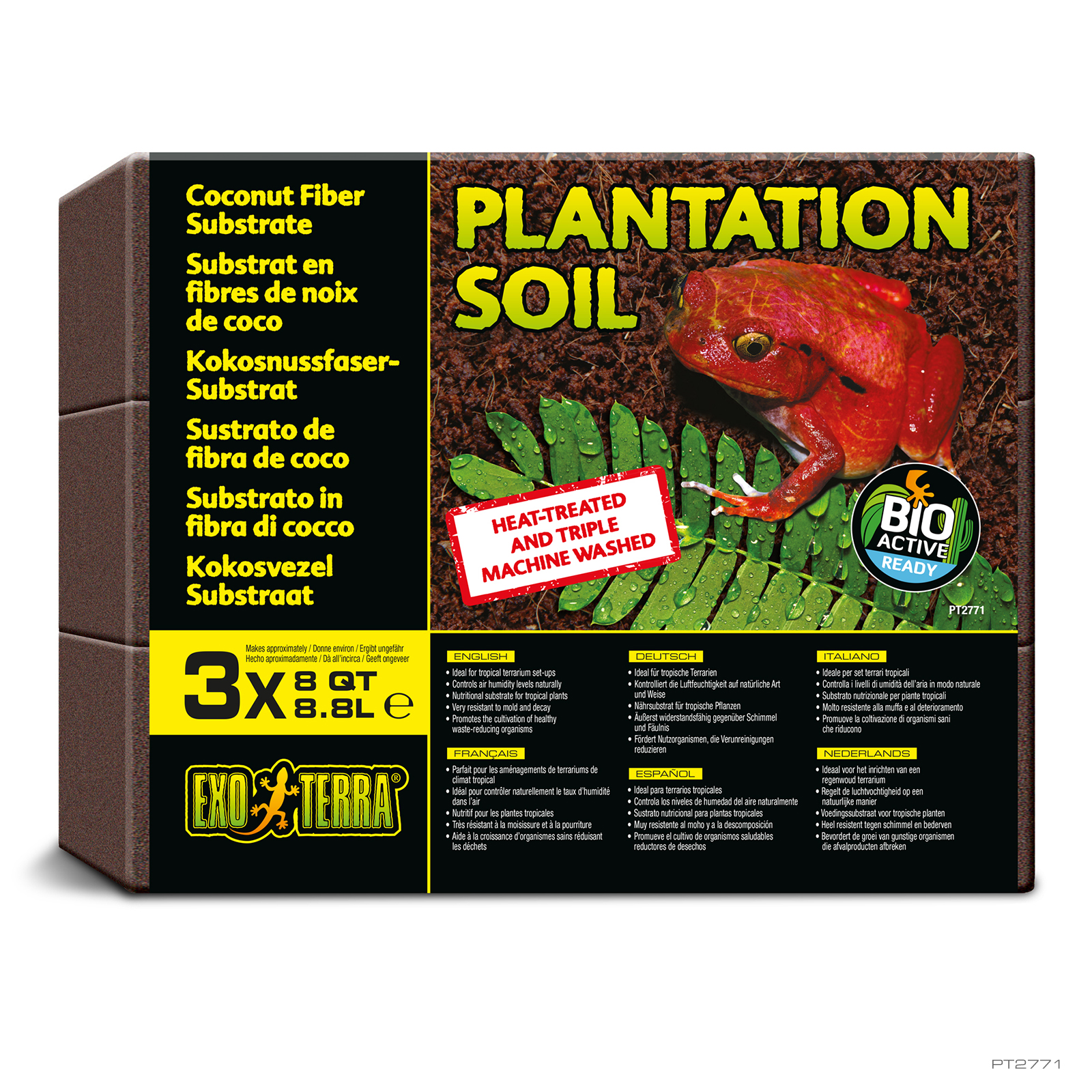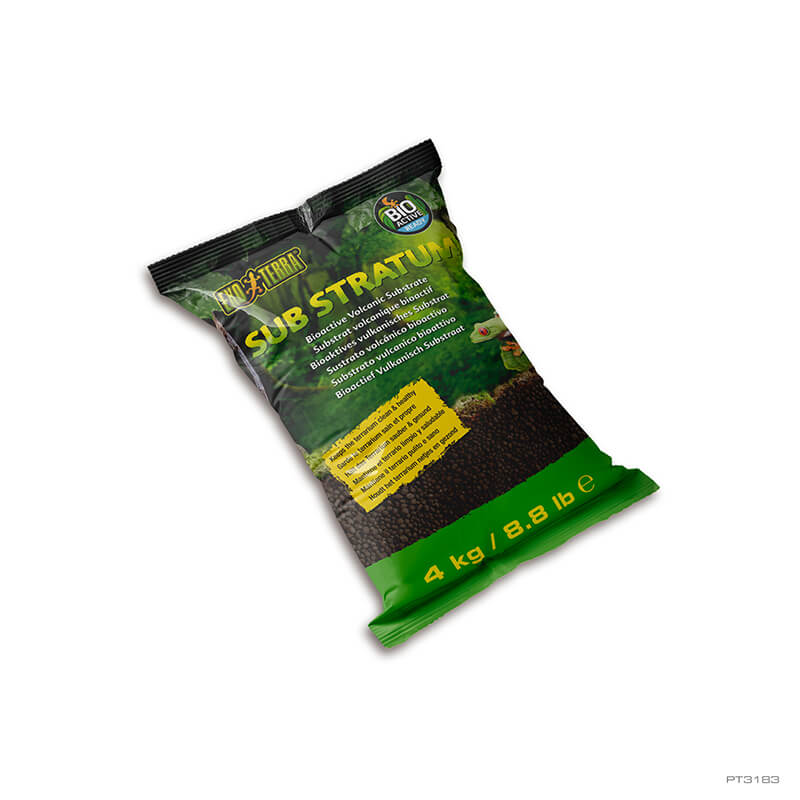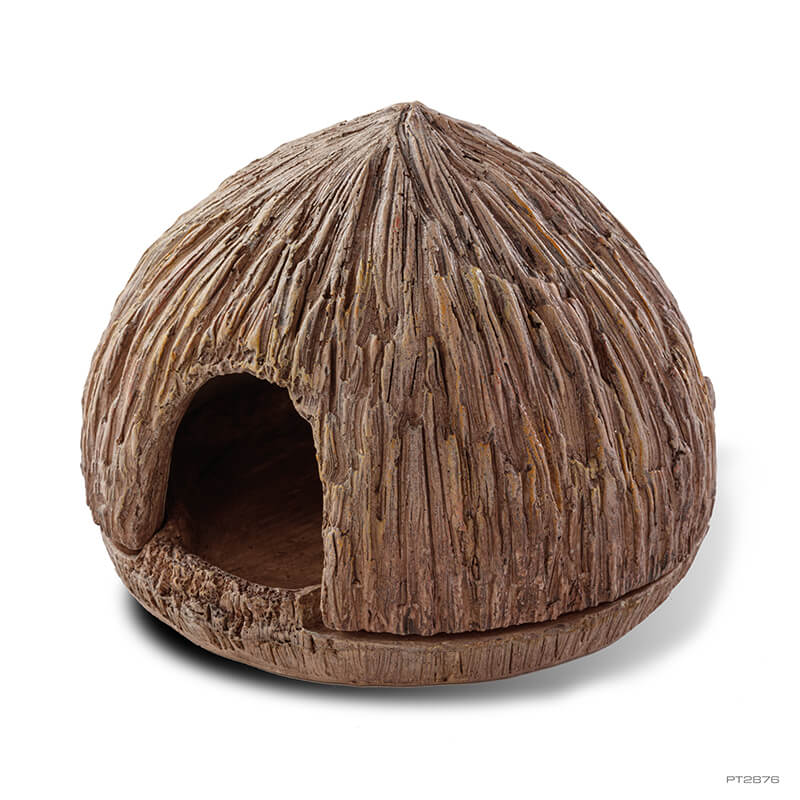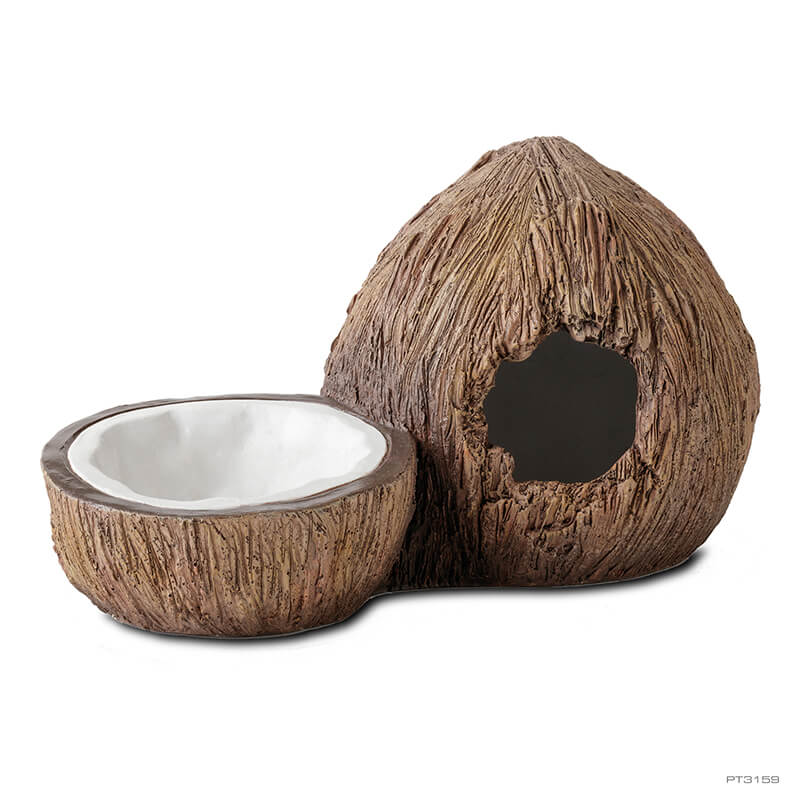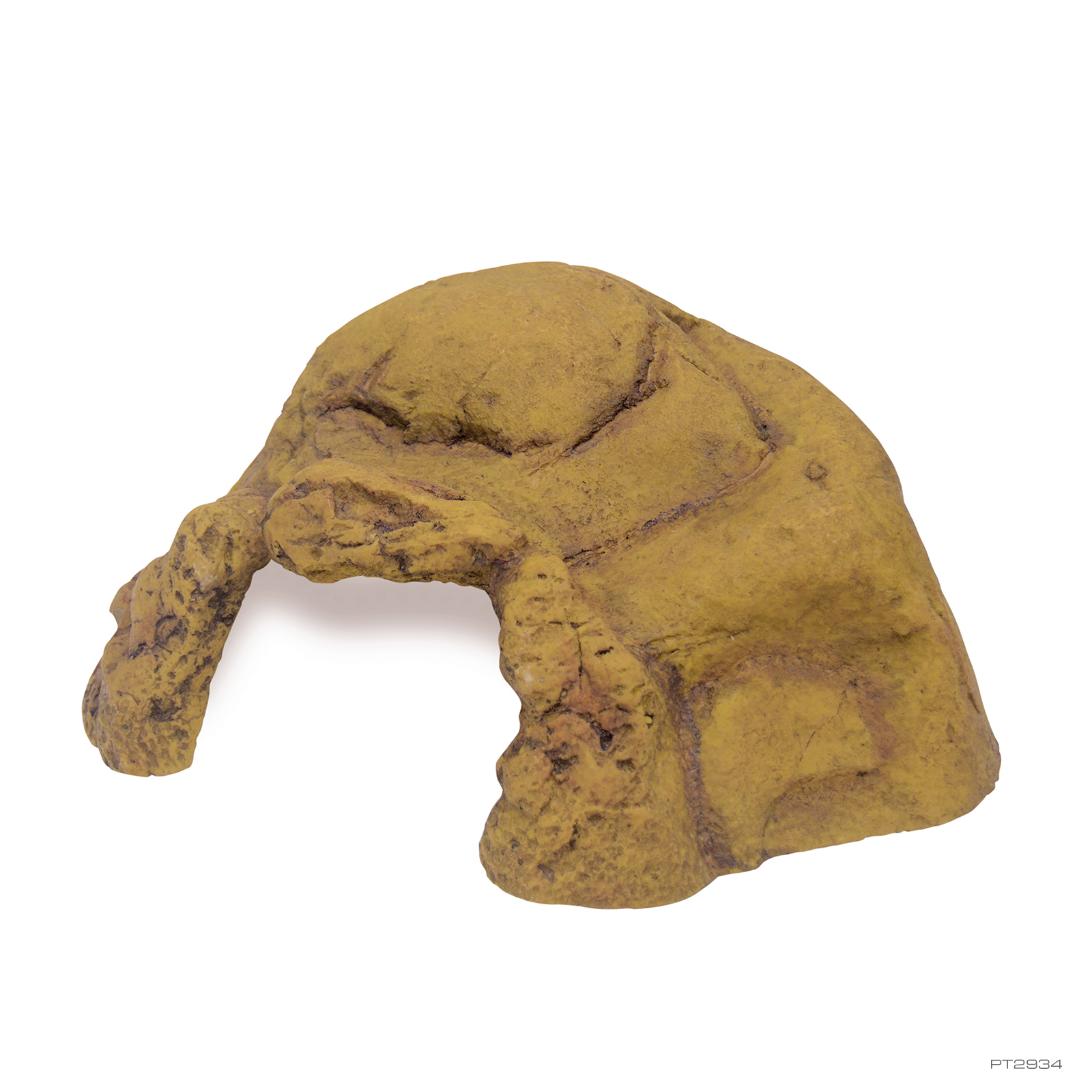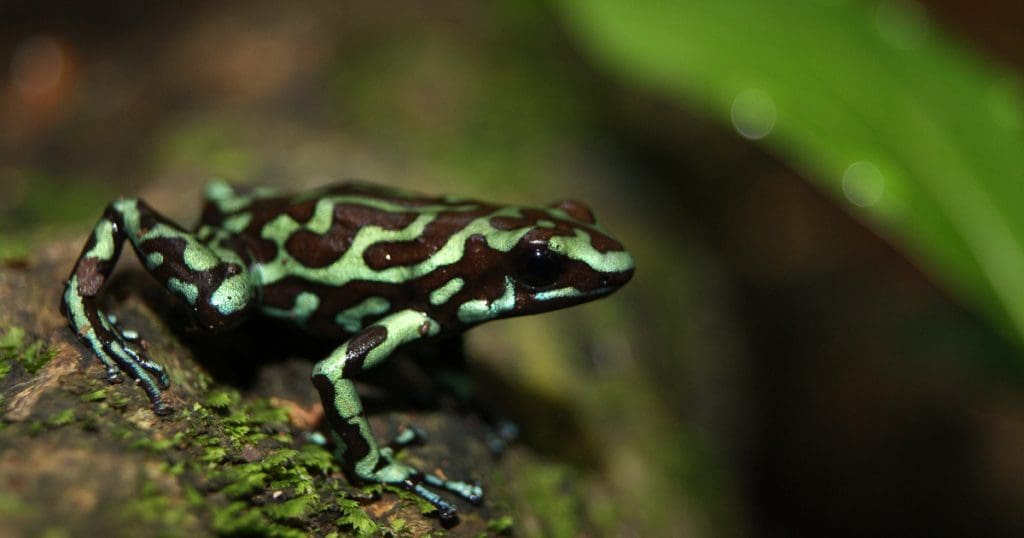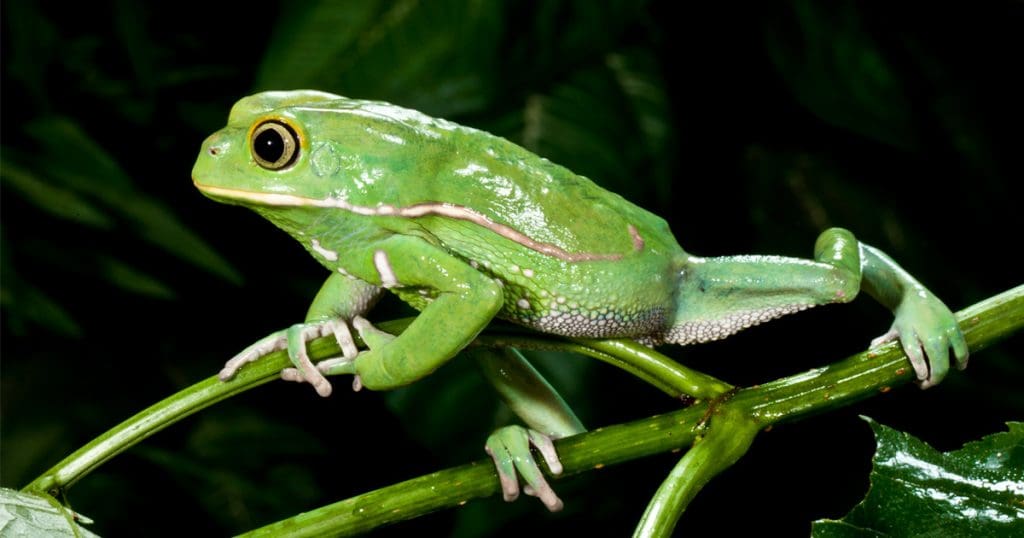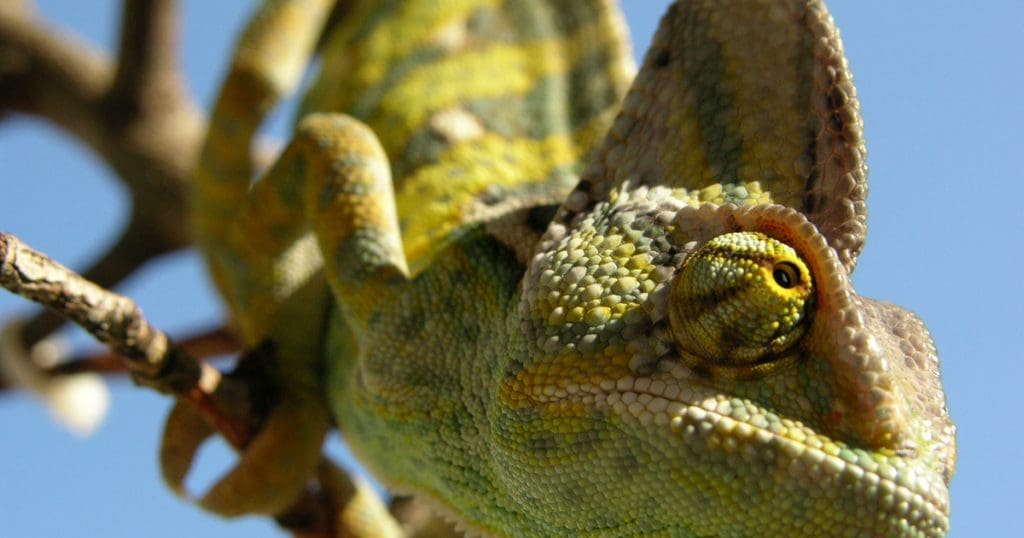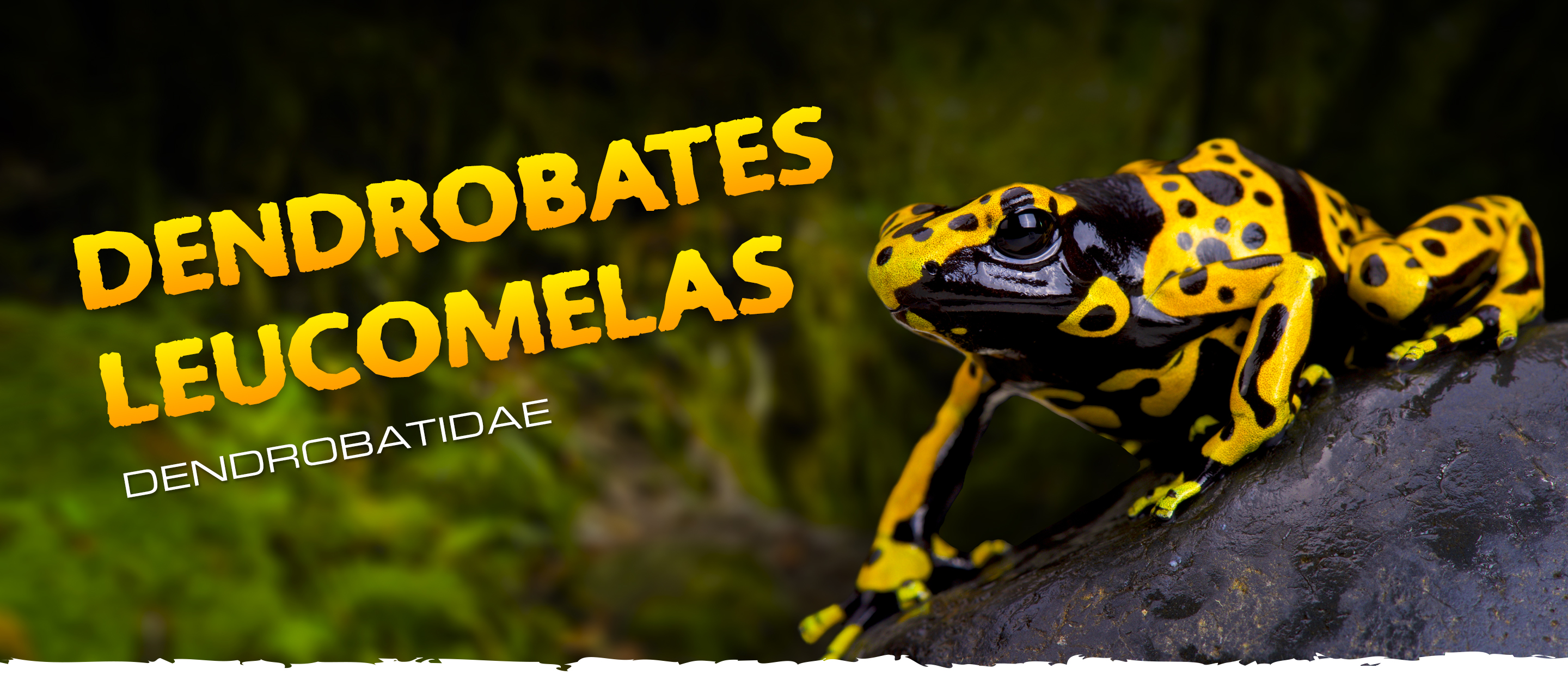
Dendrobates leucomelas
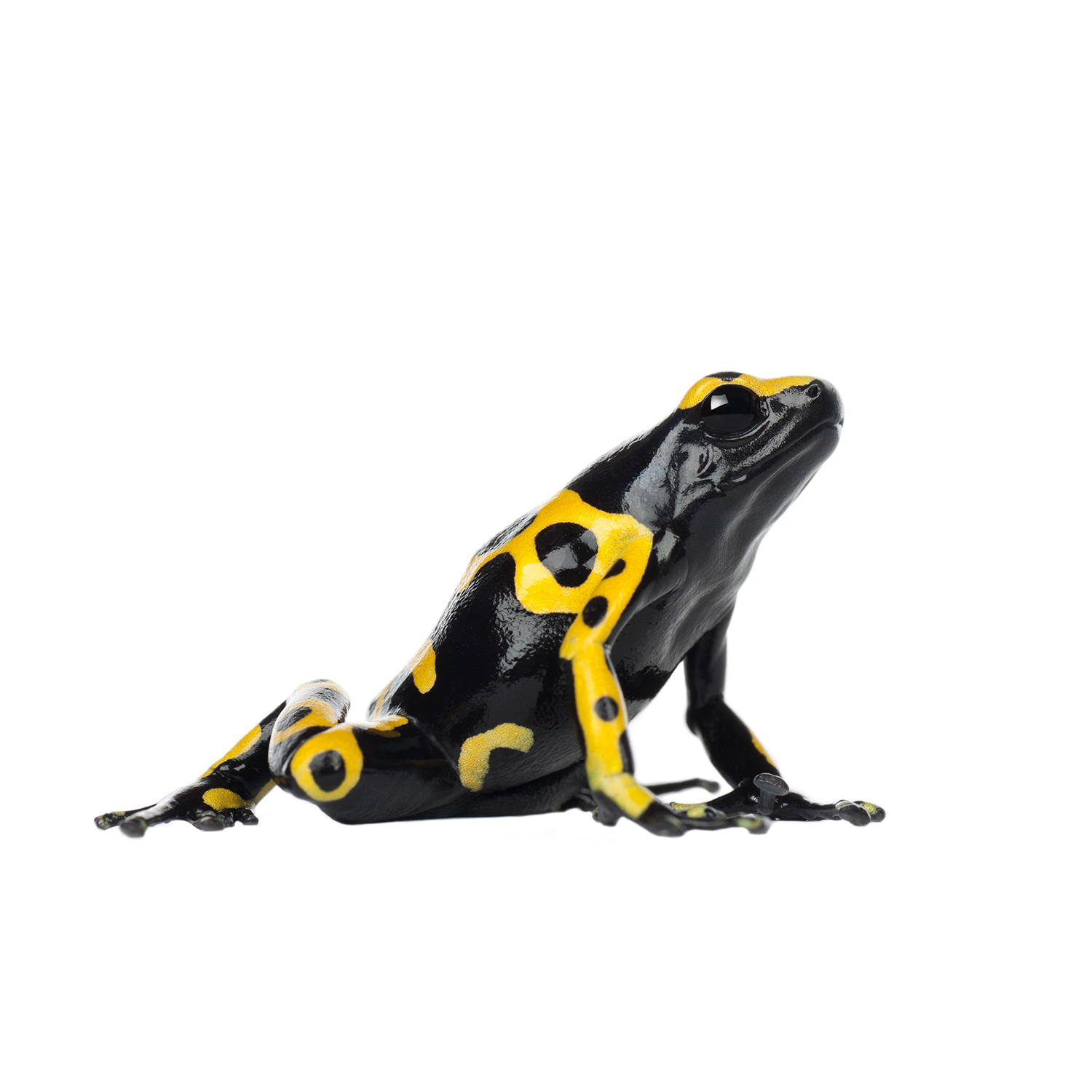

Yellow-banded Poison Dart Frog
Yellow-banded poison dart frogs are endemic to the western Guiana region and the northeastern Amazon basin of South America: southeastern Venezuela and small, adjacent parts of Colombia, Guyana and northern Brazil. They are long-lived, intriguing and “easy-to-care-for”. Because of their typical color combination consisting of a yellow to orange base color with contrasting black splotches and bands, they are also sometimes referred to as "Bumblebee dart frogs".
Like other poison dart frogs, their bright colours are actually a warning sign (called aposematic coloration) to inform predators that they are poisonous and should not be eaten.
Yellow-banded poison dart frogs live a mainly terrestrial lifestyle: they are bottom dwellers that spend most of their time on and in between the leaf litter that covers the forest floor. They do, however, also frequently climb vines and trees.
Their amazing colours and the fact that they are easy to care for make them appealing display animals for both the beginning amphibian enthusiast as well as for the advanced hobbyist. Yellow-banded poison dart frogs are best kept as pairs or groups consisting of a majority of males: females might express dominant and aggressive behaviour towards other females when there is a conflict of interest in a specific male.

History
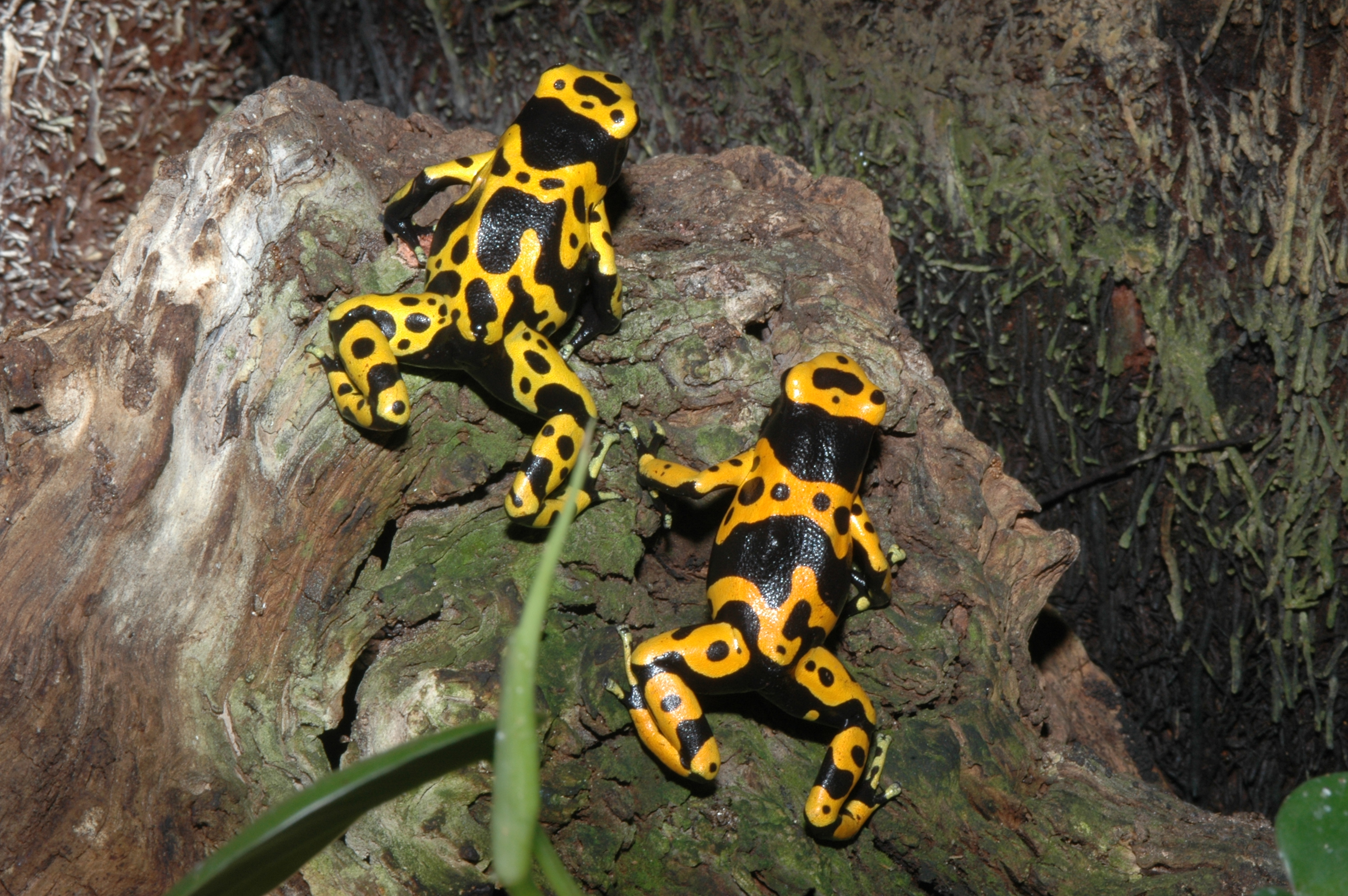
Yellow-banded poison dart frogs were first scientifically described in 1864 by the Austrian zoologist, ichtyologist and herpetologist Franz Steindachner. The species has been captive bred in the USA and Europe for more than 40 years.
The name "dendrobates" originates from the Greek words "dendro" (tree) and "bates" (walker or climber), which refers to the way these frogs are moving trough the lower vegetation layers, climbing into low bushes and tree trunks. The species specific name "leucomelas" is a combination of the Greek word "leuco" which means white and the ancient Greek word "melas" which stands for black or dark.
Characteristics
Yellow-banded poison dart frogs belong to the family Dendrobatidae, which consists of 8 genuses and more than 170 species.
Poison dart frogs are famous for their colourful appearance, which acts as a red flag to predators and signals their poisonous nature. When the frogs are stressed, tiny glands in the skin will secrete toxins resulting in a poison covered skin. In captivity, dart frogs lose their poisonous nature, and the skin toxins disappear completely in the generations that follow. This proves that the frog itself does not produce the poison, but that the poisonous substances are retrieved from the tiny invertebrates they are feeding on.
In some morphs, the darker colour will be more prominent, making up most of the frog's pattern. The black bands seen on the juvenile frogs often turn into black splotches or spots as they age.
During the mating season, males will look for an appropriate egg-laying site and try to attract females with a sharp bird-like trilling mating call.
Adult males and females range from 1,2” to 1,5" or 3,1 to 3,8 cm in total length. It is difficult to distinguish male from female frogs: males have enlarged heart-shaped discs on their front toes, but the difference between these two sexes is often too small to be sure. When they are on the same diet, females will grow slightly larger. If well fed & maintained, these frogs can live up to 20 years.
Distribution
Yellow-banded poison dart frogs are endemic to the western Guyana region and the northeastern Amazon basin of South America, more specifically: southeastern Venezuela, Guyana, northern Brazil and the uttermost eastern part of Colombia. They inhabit humid lowlands and lowland rainforests and can be found on heights ranging from 50 to 800 meter above sea level.
In the Wild
The name of poison dart frogs originates in the habit of indigenous tribes to use the poison of these frogs on the tips of blow darts. Although these darts are currently only used for hunting, it is said that in earlier times the darts were also used in wars between rivaling tribes. If you encounter these frogs in the wild, there is only a small chance of actually being poisoned; the poison is only secreted when the animal is experiencing a high level of stress, for example when it is injured or abused. It is important to mention that dart frogs are unable to synthesise their own poison; they retrieve toxic substances from their food and store these toxins in their skin.
Yellow-banded poison dart frogs are diurnal; they hunt and eat during the day. They are mainly bottom dwellers, living in between the foliage and roots that cover the forest floor. Yellow-banded poison dart frogs are the only dart frog species known to aestivate during dry spells.
During the mating season, males will look for an appropriate egg-laying site and try to attract females with a sharp bird-like trilling mating call. Once the female finds a suitable male, she will stroke his back and snout and the male will lead her towards the selected site where she will lay her eggs. The male will fertilise the eggs and will take care of them until they hatch, keeping them moist and periodically turning them over to make sure they receive enough oxygen. It takes about 2 weeks for the eggs to develop into tadpoles. When a tadpole is fully developed, the male will carry the tadpole on its back and deposit it into a, higher located, small and permanent water body where the tadpole can grow and finish metamorphosis into a young dart frog.

In the Terrarium
Yellow-banded poison dart frogs are best kept as pairs or groups consisting of a majority of males: females might express dominant and aggressive behaviour towards other females when there is a conflict of interest in a specific male.
Poison dart frogs that are bred in captivity do not pose a risk of poisoning. The frogs are fed with fruit flies, springtails, aphids and other tiny invertebrates, which lack the toxic substances that are stored in the skin by their wild counterparts. On the contrary, when handling wild caught frogs, precautions should be taken as it might take up to several years before all the toxins have disappeared. The frogs are diurnal and are best fed during the day, to avoid stress caused by the feeder animals.
Exo Terra®’s Frogs & Co range offers a wide variety of products suitable for dart frogs and other frog species. The products of the Frogs & Co range are designed to work together, helping you to create and establish a harmonized natural microhabitat. All Frogs & Co items are key components to successfully establish a bioactive planted terrarium with a thriving frog population.
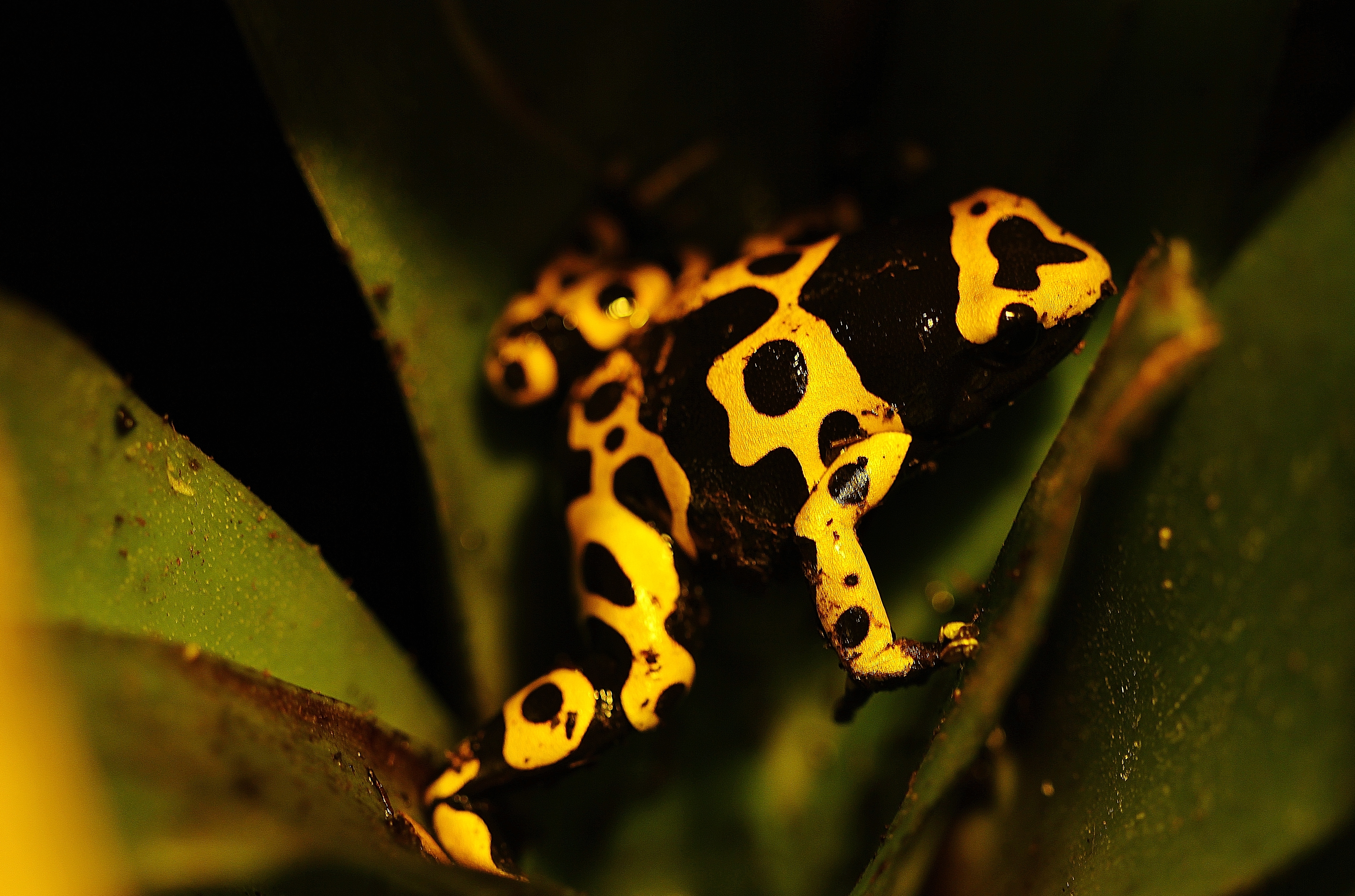
Terrarium
Exo Terra® Natural Terrariums are designed by European herpetologists and offer several housing options for Yellow-banded dart frogs. These glass terrariums feature front opening doors, allowing easy access for maintenance and feeding, and a unique double ventilation system with full screen stainless steel top.
The Exo Terra® Natural Terrarium X-Tall (Paludarium) range allows you to create a semi-aquatic terrarium habitat that replicates a rainforest, swamp or stream, and can harbour aquatic as well as terrestrial animal and plant species. The bottom part has an extra high front bottom glass, providing a higher water level and an increased water volume compared to common terrariums. A part of the aquatic section can consist of a false bottom to support the land section, accommodate and hide the aquatic appliances like filters, pumps and water heaters, and can double as a biological filtration media. Yellow-banded poison dart frogs are bad swimmers; to avoid drowning, make sure the water depth of the accessible water parts does not exceed the frog’s height.
The Exo Terra® Dart Frog Terrarium even comes with a built-in drain and tap valve which allows you to easily drain out excess spray water. The single front opening door allows maximum viewing pleasure and provides easy access for maintenance and feeding. A push-button lock keeps the terrarium secure and can even be outfitted with an optional lock to prevent unwanted opening. The hinged cover can be locked and unlocked with a single button and can be fully opened. A clear glass panel in the front ensures maximum visible light penetration and a stainless steel ventilation strip in the back guarantees optimal ventilation. The patented dual ventilation system keeps the single front glass door free of condensation, even in humid conditions. It creates a natural upward flow of air to ensure optimal and healthy conditions. Excess heat is dissipated through the top mesh and prevents heat from accumulating, creating temperature gradients in the terrarium. The screen mesh allows UV and infrared penetration when these bulbs are required. Four self-closing inlets for wire/tubing in the back facilitate the installation of powered accessories like waterfall pumps, filters, the Exo Terra®'s Monsoon, etc. The inside front of the lid has a Monsoon Nozzle mounting point on each side of the terrarium. The bottom part of the terrarium is waterproof once the tubing, elbow-connector and tap valve are connected to the drain. The drain allows hassle free water changes and excess water removal.
The Exo Terra® Frog Terrariums can be set up as a bioactive habitat for dart frogs, smaller tree & reed frogs, newts and salamanders, small geckoes & lizards, garter & grass snakes, etc.
Horizontally oriented enclosures like the Low and Wide Natural Terrariums are a great choice to house a small group of Yellow-banded Poison Dart Frogs, since they live a mainly terrestrial lifestyle:
The set-up can be a simple “forest floor” terrarium or a more natural bio-active type set-up with a separate land and water part mimicking a lakeshore or riverbank, by using the Bio Drain system. With a combination of hides (Coconut Cave), leaf litter (Equatorial Forest Floor substrate) and artificial and live plants, you can provide a suitable environment consisting of substrate, foliage and secure hides which will allow the poison dart frogs to live comfortably.
DISCLAIMER In regards to the pet species and number of specimens to be kept in a terrarium, always comply with the species specific Rules and Regulations in your Country of residence.
DISCLAIMER The terrarium should be placed in a room receiving only indirect light from windows. Do not place the Terrarium near a window where it can receive direct sunlight, as this could cause the terrarium to overheat and stress or kill your Poison Dart Frogs.
Lighting
A 12-hour day/night cycle will benefit your frogs and stimulates live plant growth. The Exo Terra® TerraSky Planted Terrarium Light is ideal for planted setups, paludariums and bioactive terrariums. The high intensity and enhanced penetration ensure that the light reaches all layers of the terrarium, resulting in sustained lush plant growth. Orchids, Bromeliads, Tillandsias (air plants), carnivorous plants, mosses and lichen all thrive under the TerraSky Planted Terrarium Light’s strong Photosynthetic Active Radiation (PAR). The 120-degree light dispersion provides a nice even illumination and covers the complete area to avoid dark spots.
Providing UV-lighting is not absolutely necessary, but the correct amounts of UVB will help your frogs to metabolize calcium and prevent metabolic bone disease. The combination of the correct UVB wavelength and heat enables the animals to produce their own vitamin D3 for proper calcium absorption and prevents metabolic diseases (e.g., MBD). We highly recommend the use of our Reptile UVB100. The low levels of UVB rays produced by these bulbs are very beneficial for the animal's overall health, while the UVA rays stimulate appetite, activity and reproductive behavior.
Heating
Monitoring
During the day, an average relative humidity of 70-80% and temperature of 77-84°F or 25-29°C should be maintained. At night, humidity should rise up to about 100% and room temperature can drop with 9-14°F or 5-8°C. Use the Exo Terra Digital or Analog Thermometers and Hygrometers to help you monitor the terrarium conditions and adjust the temperature and relative humidity to meet the needs of the animals.
For more security and peace of mind, the Exo Terra® Thermostats or Thermostat & Hygrostat will help to prevent overheating and undercooling during hot summer days or cold winter nights. Apart from the temperature, the Exo Terra® Thermostat & Hygrostat will also keep the humidity at the desired level. With the Exo Terra® Thermostats or Thermostat & Hygrostat, you can create a well-controlled heating/humidifying system that allows you to maintain the required temperature and/or humidity conditions similar to those found in your animal's environment.
Substrates
Yellow-banded Poison Dart Frogs thrive well in a paludarium setup or in a bioactive terrarium setup with a water dish or preferably elevated waterbodies.
The Paludarium’s living space consists of 3 distinct zones:
Terrestrial Zone The terrestrial zone is a land area with plants, trees, bushes and rocks that never submerge. In tropical climates, a variety of invertebrates, reptiles and amphibians occur here.
Riparian Zone The riparian zone or riverbank is the interface between land and water. It is inhabited by semi-aquatic reptiles and amphibians.
Aquatic Zone The aquatic zone can be a stream, pond or even lake – home to turtles, aquatic amphibians, fishes and freshwater shrimps.
To create the Terrestrial and Riparian Zone, you can use Bio Drain Substrate with a Bio Drain Mesh, topped with Exo Terra® Sub Stratum and/or Plantation Soil, covered with leaf litter and/or moss (Exo Terra® Equatorial Forest Floor or Forest Moss). The non-toxic Bio Drain mesh will keep the underlying Bio Drain Draining Substrate separated from the decorative top-layer substrate. It will prevent substrate particles from contaminating the water while still allowing proper water drainage. In combination with the Bio Drain Substrate you can create water parts and a biological filtration system in the terrarium. The clean terrarium water can then be circulated in Waterfalls, Cascades or Dripping Plants. In the Terrestrial Zone you can build your decorative layer with plants, branches, lianas, rocks, hides, etc. The actual substrate layer that will be used for planting can consist of mixture of Exo Terra® Sub Stratum with Exo Terra® Plantation Soil. The Riparian Zone remains somewhat open, with some smaller pebbles, or flat wood or stone pieces that allow easy access to the Aquatic Zone. For the Aquatic Zone, Turtle Pebbles are a great choice as their dimensions are big enough to avoid being swallowed by the frogs, but offer a stable substrate and are easy to clean.
The Exo Terra® Sub Stratum is a natural volcanic soil with live beneficial bacteria. The porous surface and low density structure allow for excellent drainage and aeration, but it also promotes a flourishing population of beneficial, nitrifying bacteria, creating a self-sustaining, living terrarium ecosystem. The active beneficial bacteria of the soil will decompose biological waste, keeping the terrarium clean and healthy. By mixing the Sub Stratum with other organic substrates, you enrich any substrate with the required minerals like calcium, nitrogen, potassium and phosphorus. It also aids in the water retention capacity and provide adequate air supply to the roots.
The Exo Terra® Equatorial Forest Floor is a multi-layer substrate that allows you to recreate the forest floor as found in natural equatorial forests. The Equatorial Forest Floor provides a base layer and a top layer. The base layer consists of a rich organic matter from ground coconut husk fiber. It is a 100% natural, ecological and biodegradable substrate with great hygroscopic properties. The top layer consists of sun dried decorative Ardisia leaves from a sustainable resource. The top layer covers the actual substrate underneath to facilitate its moisture retention and prevent the soil from drying out.
The Exo Terra® Forest Moss is real compressed moss grown in tropical Asia and does not contain any dyes or chemicals. This ecological substrate is extremely absorbent and ideal for increasing humidity in the terrarium. It is totally safe for use with frogs, salamanders and burrowing or digging animals.
The Exo Terra® Plantation Soil is a 100% natural, biodegradable terrarium substrate made from sustainable, ground coconut husk fiber grown on plantations in tropical Asia. The unique hygroscopic properties of this ecological substrate regulate the terrarium’s humidity in a natural way and is totally safe for frogs, salamanders and other burrowing or digging animals. The unique coir pith used for the Exo Terra® Plantation Soil consists of a mixture of short fibres and coco-peat grain sizes ranging from coarse granules to fine clumps resulting in improved soil drainage and aeration. The improved aeration of the substrate promotes the cultivation of healthy waste-reducing organisms keeping your terrarium fresh and clean.
The substrate should be kept moist at all times, but definitely not soaking wet. Make sure to offer different gradients of moisture inside the terrarium. Some parts can be kept rather moist while other parts should be kept somewhat drier. Also, try to vary the moisture depending on the season, spray more frequently during the warmer parts of the year.
The Exo Terra® substrates will help maintain the substrate moisture at an optimal level. Providing a top layer of Exo Terra® Equatorial Forest Floor or Forest Moss will also facilitate the substrate's moisture retention and prevent it from drying out. The ardisia leaves or forest moss also provide hiding spots for the reptiles and amphibians foraging the forest floor and at the same time, facilitate the natural ecosystem where beneficial organisms will break down waste products and thus reduce odors.
The secret to growing healthy plants begins with the soil. Naturally, healthy soil contains living microorganisms — from bacteria to fungi, protozoa and arthropods. Together they form a choreographed exchange from the recycling of nutrients to the decomposition of organic materials.
Plants
The land part of the terrarium can partially be decorated with live and/or Exo Terra® artificial or smart plants. Live plants and moss will contribute to the filtration capacities of your terrarium. This type of setup allows you to create an effective filtration system, mirroring the process of natural biological filtration. A fully functioning aqua-terrarium or paludarium will provide a constant source of clean water, which is imperative to keep semi-aquatic species. It is basically a small, closed ecosystem.
Ideal for Poison Dart Frogs are small fern species and epiphytes like Bromelias, Tillandsias and orchids. Combine this with live moss and small-leaved vining plants to create a varied planted setup.
The Exo Terra Dart Frog Bromelia is a very realistic bromelia as found in most frog habitats. The overlapping waxy leaves provide an ideal platform for the female frogs to deposit their eggs. The urn-like rosette retains water, used by the frogs as pools and to deposit their tadpoles, and is detachable for easy cleaning or for collecting the tadpoles.
Many hobbyists choose to introduce live plants in pots that are buried in the substrate and concealed with decor items, like cork bark or rocks. The Exo Terra® Snake Bowl can be used as a decorative planting pot. Its extra deep design makes it suitable for small to medium live terrarium plants.
DISCLAIMER Make sure the plants have no pests before introduction and rinse leaves thoroughly to remove any pesticide residues.
Exo Terra® offers a wide range of artificial plants with the same advantages as live plants; they're decorative, they provide shade, and they create hiding spots and visual barriers to let your reptiles and amphibians experience an increased feeling of safety and reduced stress. Exo Terra®'s artificial plants are exact copies of their natural counterparts to blend in well with live plants but are much easier to maintain. A combination of live plants and Exo Terra®'s artificial plants allows you to fully plant a terrarium, even in the hottest or driest parts.
Exo Terra®'s Bromelia, Scindapsus, Philodendron and hanging Plants are easy to clean & maintain, while the weighted base of the Bromelia, Scindapsus, Philodendron allows you to easily position the plant after maintenance.
Hide Outs
Poison dart frogs are easily frightened creatures that hide rather quickly, at the slightest disturbance of their surroundings. Strangely enough, they will show up in the open much more if provided with ample secure hiding places; it will make them feel safe and secure knowing their comfort zone is within immediate reach. The Exo Terra® Coconut Cave is the perfect hiding and egg-laying cave for your poison dart frogs. In a constantly moist environment, its irregular surface will slowly start to overgrow with moss, adding to the natural look of the cave.
Decor
Landscaping a terrarium will not only encourage the frog's activity and exploratory behaviour, but also provide extra cover, which increases the frog's sense of security and reduces its stress levels.
Next to the necessary items like leaf litter, plants and hideouts - the terrarium can be “beautified” with some additional decor items. However, care needs to be given to not over clutter the open space in the terrarium.
Waterfalls and Cascades add aesthetic appeal and will help oxygenate and biologically filter the water.
Exo Terra offers a wide variety of innovative decor items like Skulls, Waterfalls, Smart Plants, Ground Cover Plants, etc. - all which add, next to personalising accents, some more environment enrichment and features.
Nutrition
Yellow-banded poison dart frogs feed on tiny, live insects and other arthropods. Fruit flies can be fed as a staple diet, complemented with other live prey such as aphids, springtails, bean beetles, rice flour beetles, small fly larvae and pinhead crickets. The length of their prey should not exceed 3 mm or 0,1 inch. Always dust your feeder insects with a 1:1 mix of Exo Terra® Multivitamin and Calcium +D3 powder supplement – feed juveniles daily and adults every second or third day. Overfeeding should be avoided: an excess of feeder insects can dangerously stress out the frogs. Never feed more then the frogs can eat during a period of 2 minutes.
Because commercially raised insects tend to be deficient in calcium and several vitamins, they must be supplemented by coating with a reptile vitamin and mineral supplement such as Exo Terra® Multi Vitamin blended with an equal part Calcium. Always dust your feeder insects with a 1:1 mix of Exo Terra® Multivitamin and Calcium +D3 powder supplement using the “shake & bake” method of coating insects.
Water
The presence of clean and fresh water is important for the proper care and maintenance of captive reptiles and amphibians.
Dart frogs have a thin, highly permeable skin, which makes them susceptible to dehydration and sensitive to toxic chemicals. Instead of drinking, they absorb water through their skin to stay hydrated. Therefore, a high humidity should be maintained inside the terrarium and extra attention must be paid to the water quality. Always treat tap water with Exo Terra® Aquatize to remove harmful heavy metals, chlorine and chloramines, necessary to provide safe healthy water for your amphibians. In a bio-active set-up, you can use Turtle Clean (PT1998) to add beneficial organisms to the terrarium water and speed up the biological filtration capabilities. Liquid Electrolyte and Calcium can be added to the water to support healthy bone and muscle growth in your frogs and especially tadpoles.
A shallow Water Dish with clean, de-chlorinated water should be available at all times. Exo Terra® Water Dishes, and specifically the Exo Terra® Frog Ponds are ideal because they are shallow, have a natural appearance and are easy to clean and disinfect. The Frog Pond’s unique shape allows you to install the pond semi-recessed in the substrate to mimic a riparian zone. This design offers easy access for dart frogs to hydrate while the shallow water body and integrated steps prevent the animals from drowning.
Yellow-banded poison dart frogs can’t swim so make sure that the maximum depth of the Water Dish or other water bodies in your terrarium does not exceed the height of the frog. If necessary, add Exo Terra® Turtle Pebbles to decrease the water depth.
The average humidity should be kept between 70-80% with peaks of 100% in the morning and evening (when the terrarium is sprayed/misted), similar to what these frogs experience in nature. The Exo Terra® Monsoon is a handy device to guarantee that your frog terrarium is sprayed at a set time every day. The Exo Terra® Humidifier can help maintain the correct relative humidity in the terrarium, especially if used in combination with the Exo Terra® Thermostat & Hygrostat. Although a high humidity is mandatory, a minimum of ventilation is required to avoid the growth of fungus and rotting of plants. The patented dual ventilation system of the Exo Terra® Natural Terrariums and Frog Terrariums provides the ideal amount of ventilation, without compromising the required relative humidity.
Maintenance
Land area;
Spot-clean your Yellow-banded Poison Dart frog’s enclosure once a week, or more if necessary, in order to prevent harmful bacteria to build up; remove fresh or dried faeces, leftover foods, etc. For a more thorough cleaning, remove all the decor pieces and clean these with warm water. Stirring and mixing the moist substrate will allow soil bacteria to break leftover traces of waste down. Always keep a keen eye on the substrate; as long as the substrate is not degrading or does not have a foul odour, the spot cleaning process is sufficient. Once the substrate starts to degrade or spreads a foul odour, it needs to be replaced completely.
Water part;
When using a water circulation pump or filter, it is best to clean the water inlet and filter media every 2-3 weeks to ensure optimal performance. Water changes should be performed on a bi-weekly basis; remove about ¼ to ⅓ of the water and replace it with fresh water of the appropriate temperature. Partial water changes can help to remove toxic substances or improve the overall water quality. Unless really necessary, make sure to never perform entire water changes, as this will also remove beneficial bacteria and organisms. Always treat tap water with Exo Terra® Aquatize to remove harmful heavy metals, chlorine and chloramines when performing water changes. Use Turtle Clean (PT1998) to assure that the beneficial organisms in the terrarium water remain at an ideal level to keep the biological filtration system performing well.
Juvenile Dart Frogs should be fed daily, while adults only need feeding every other or third day.
The terrarium should be misted at least twice a day, depending on the relative humidity, preferably with purified or distilled water to prevent mineral stains on the glass.
Live plants should be watered once a week whether in pots or planted directly in the substrate.
Clean the inside glass and decoration once or twice a week with plain water to remove any waste matter. The outside (NEVER the inside) glass can be cleaned with a paper towel and window cleaner.
Breeding
In the wild, the breeding season of Yellow-banded Poison Dart Frogs coincides with the rainy season, which lasts from May to November. To stimulate breeding, simulate the rainy season after a drier period by increasing both length and number of the spray intervals of your misting system.
Unlike other frog species, amplexus does not occur in dart frog species. The male Yellow-banded poison dart frog will look for an appropriate egg-laying site: often a dark hide with a smooth bottom surface. Hides such as the Exo Terra® Coconut Cave are the perfect egg-laying cave for your poison dart frogs. Once the male finds a suitable site, he will try to attract a female with a sharp bird-like trilling mating call. When the female finds a suitable male, she will stroke his back and snout and the male will lead her towards the selected site where she will lay 2 to 10 eggs. The male will fertilise the eggs and will take care of them until they hatch, keeping them moist and periodically turning them over to make sure they receive enough oxygen.
It takes about 2 weeks for the eggs to develop into tadpoles. When a tadpole is fully developed, the male will carry the tadpole on its back and deposit it into a, higher up, small and permanent water body where the tadpole can grow and continue its metamorphosis into a froglet. The rosette of the Exo Terra Dart Frog Bromelia allows you to replicate these natural, permanent water bodies. Cannibalism between tadpoles is possible, so It is advisable to keep them separate.
Once the tadpoles start swimming they will start feeding on frog & tadpole food, dead insects, chopped earthworms, fish food flakes, algae, plants, etc… It takes the tadpoles approximately 2-4 months to fully metamorphose into air-breathing amphibians. In this stage it is critical to provide the metamorphosing tadpoles with sufficient plants, branches or a smooth levelled riverbank so they have easy access to the land area.
The newly-emerged frogs will absorb the remnants of their tail for the next few days and will start feeding on food items of appropriate size like fruit flies and aphids. As with adults, always dust your feeder insects with a 1:1 mix of Exo Terra Multivitamin and Calcium +D3 powder supplement. The freshly metamorphosed frogs can be raised under similar conditions as used for the adult frogs, just make sure the water isn’t too deep, and there are slopes available so the frogs can easily climb onto land areas.
Handling
We don’t recommend the handling of Poison Dart Frogs if unnecessary. Extra care should be taken when handling wild caught animals, as their skin can keep the poisonous characteristics up to several years after the animals' introduction into the terrarium. We recommend using rubber gloves when handling wild caught Poison Dart Frogs.
Poison Dart Frogs are animals that are best observed, as they do not appreciate being picked up or handled. When manipulating Dart Frogs, they will quickly become stressed. Like most amphibians, Dart Frogs have a very sensitive skin, and are especially sensitive to chemicals like soap, lotion, etc. so make sure to always thoroughly wash and rinse your hands with warm water before and after handling any amphibian.
Every amphibian’s skin contains very mildly toxic substances that can irritate eyes or open wounds so always thoroughly wash and rinse your hands with warm water before and after handling any amphibian. If you accidentally touch your eyes while handling an amphibian, you might experience a somewhat burning sensation. Should this happen, make sure to rinse your eyes immediately and thoroughly with water, that should relief the burning sensation immediately.

Conclusion
Yellow-banded Poison Dart frogs are a long-lived, robust and “easy-to-care-for” species, making them an ideal beginner’s animal. The various pattern morphs make these frogs great display animals, especially when housed in a well-decorated, planted terrarium. Thanks to their small size, they will not damage fragile plants like orchids. This allows you to create an interesting, exciting and colourful piece of rainforest-like ecosystem, inhabited by both plants and animals.
Yellow-banded Poison Dart Frogs have been captive bred in the USA and Europe for more than 40+ years, and captive bred youngsters are readily available in reptile stores as well as from breeders.

Did You Know?
Yellow-banded Poison Dart frog’s toxicity works as a defense mechanism against predators, but also prevents bacterial and fungal infection. Their thin, highly permeable skin makes them extra susceptible to these types of infections. In humid environments, where both fungus and bacteria thrive, this is a very welcome trait.
On the contrary of other frog species, Poison Dart Frogs take care of their offspring. The eggs are guarded and protected by the parents during the development.
While taking care of the eggs, the male Yellow-banded dart frog periodically turns them so they receive enough oxygen. Once the tadpole is fully grown, one of the parents (typically the male) will transport the tadpole to a small pool of water. But, it does not stop here: the male will keep guarding the tadpole while it feeds and grows inside this tiny pool, until it reaches the final stage of its metamorphosis.
Cannibalism between tadpoles is possible, so it is advisable to keep the tadpoles separate.
Yellow-banded poison dart frogs are the only dart frog species known to aestivate during dry spells. This is one of the reasons the species is hardy and so easy-to-care for, and a great choice to start keeping dart frogs.
Frequently Asked Questions
Is a Yellow-banded Poison Dart Frog the right choice for me?
Yellow-banded Poison Dart Frogs are great animals; they are beautiful, long-lived and “easy-to-care-for”, on top of that, they come in a variety of pattern morphs. Keep in mind that Yellow-banded Poison Dart Frogs are display animals, they don't like to be handled. If you are intrigued by the rainforest ecosystem, they are the perfect choice. Their small size does not endanger the wellbeing of fragile plants like orchids, which allows you to recreate a complete piece of this beautiful ecosystem, including live plants, flowers and mosses. Yellow-banded Poison Dart Frogs are readily available and they're captive bred, making them safe animals to start with.
Should I feed a variety of food items to my Yellow-banded Poison Dart Frog or can I stick to just 1 type feeder insect?
Bring as much as possible variation in your Yellow-banded Poison Dart Frog’s diet to make sure that your frog receives all possible essential nutrients.
Can I keep other species of amphibians and reptiles together with my Yellow-banded Poison Dart Frogs?
Hobbyists have reported good as well as bad experiences in regards to keeping this species together with other species. In general, we would advise that Yellow-banded Poison Dart Frogs should definitely not be kept together with other bottom dwelling and/or diurnal species, as this could create a stressfull environment.
Are Yellow-banded Poison Dart Frogs poisonous?
Poison dart frogs that are bred in captivity do not pose a risk of poisoning. The frogs are fed with fruit flies, springtails, aphids and other tiny invertebrates, which lack the toxic substances that are used by their wild counterparts to store in their skin. On the contrary, when handling wild caught frogs, precautions should be taken, as it might take up to several years before all the toxins have disappeared.
Can I feed my Yellow-banded Poison Dart Frogs wild caught insects?
We do not recommend feeding wild caught insects as these can harbour harmful bacteria. They may also have come in contact with gardening chemicals, making them poisonous for your Frogs.

Other species
Trachycephalus resinifictrix
Amazon Milk Frogs are native to Colombia, Equador, Peru, Bolivia, Venezuela, Suriname, Guyana & French Guyana and Brazil. They prefer tropical primary rainforests up to an elevation of 450m above sea level. The type locality of the Amazon Milk Frog referenced in the original description is Maracanã River in Pará, Brazil.
The Amazon Milk Frog's common name refers to the milky white secretions that these frogs release when they feel threatened. This behavior, however, is rarely seen in captive Milk Frogs. Trachycephalus resinifictrix is also sometimes referred to as the Mission Golden-eyed Tree Frog because the pupil in their golden iris resembles a black Maltese cross.
Amazon Milk Frogs are adorable, long-lived and “easy-to-care-for” amphibians. Their engaging personalities, the bluish-green color with distinct brown to black pattern, their blueish lips and toe pads and big golden eyes make them appealing display animals for both the beginning reptile enthusiast as well as for the advanced hobbyist.
Amazon Milk Frogs live an arboreal lifestyle, sleeping on the branches or in bark crevices and hollow tree trunks, always in the vicinity of the water filled tree holes they use for their reproductive cycle.
Amazon Milk Frogs are a fairly social species and are best enjoyed when kept in small groups of 4 to 8 animals. The interaction between the animals in these small groups increases the viewing pleasure but also stimulates their mating behavior.
Amazon Milk Frogs have been captive bred in the USA and Europe for more than 20+ years, and captive bred youngsters are readily available in reptile stores as well as from breeders.
Pogona vitticeps
Bearded Dragons are native to Australia. Both the scientific and the common name of the Bearded Dragon refer to the spiny “beard” (or pogon in Ancient Greek) which can be puffed up and darkened in coloration whenever the Bearded Dragon gets excited, stressed or wants to impress and opponent. No need to panic; the spines on the thorny triangular-shaped head and spiny torso of these Dragons may look frightening but are actually very soft when touched.
Their relatively small size and docile nature but especially their love for attention, make these gentle dragons an attractive species for both the beginning reptile enthusiast, advanced hobbyist and even for kids. And moreover, unlike night active creatures, your Bearded Dragon is awake when you are awake.
Bearded Dragons have been captive bred in the USA and Europe for over 30 years. Since Australia already banned the export of native fauna and flora in the 1960’s, all currently available Bearded Dragons are captive bred over generations.
Bearded Dragon youngsters are now readily available in their natural color and pattern, but also in a multitude of color morphs. The list of designer morphs available is extensive and still growing. Where it started with twisting and tweaking the color and pattern, the latest morphs even have a different scalation. There's a lot of cool morphs available with appealing names like Sandfire Red, Sandfire Yellow, Sandfire Pastel, Tangerine, Hypo Melanistic, Witblits, Paradox, Citrus Tiger, Lemon Fire and many more. But, as stated before, not only the colors can be isolated and enhanced by selective breeding, also some specific morphological characteristics, like size or scales can be engineered: German Giants (larger than the average Bearded Dragon), Leatherback (smooth back, no spikes), Silkback (smooth skin), etc.
Dendrobates auratus
The green-and-black poison dart frog, or Dendrobates auratus, is a captivating amphibian native to southeastern Nicaragua, Costa Rica, Panama, and northwestern Colombia. Recognizable for its long lifespan, the species is also notable for being relatively easy to care for, making it an appealing choice for hobbyists and researchers alike.
Its vivid mint-green base coloration punctuated with black splotches sets it apart visually. However, this species displays a fascinating trait known as color polymorphism. Individuals can exhibit varying shades, with base colors ranging from green to blue, yellow, and even white. The darker splotches, a characteristic signature of the species, vary from bronze to black.
Just like other poison dart frogs, their bright colors serve a crucial evolutionary purpose. They exhibit aposematic coloration, wherein the vibrant hues deter potential predators by signaling the frog's toxic nature, discouraging them from considering the frog as prey.
Primarily terrestrial, green-and-black poison dart frogs are bottom dwellers, spending most of their time navigating through the leaf litter blanketing the forest floor. However, they frequently venture upwards, climbing vines and trees in their tropical habitats.
These frogs are attractive display animals for beginner and advanced amphibian enthusiasts. Their stunning coloration, coupled with their relative ease of care, make them popular choices for terrarium inhabitants. They are best kept as pairs or in groups with most males, as females may exhibit aggressive behavior towards each other when vying for a specific male's attention.
Initially, these creatures may exhibit shy behavior. However, when housed in a well-planted terrarium offering plenty of hiding spots, they quickly become more active, adding a dynamic element to their display. With their intriguing behaviors, rich color variation, and their adaptability, Dendrobates auratus offer a unique glimpse into the vibrant world of amphibians.
Phyllomedusa sauvagii
Waxy Monkey Tree Frogs are native to the South American rainforests, humid montane forests, and dry forests in the Chacoan region of eastern Bolivia, northern Paraguay, Mato Grosso do Sul of central Brazil, and Northern Argentina. They primarily prefer moist and semi-moist forest habitats but can also cope with drier environments.
They are sometimes referred to as Chacoan Monkey Leaf Frogs as well, because of the Chaco Region they originate from, and because the females lay their eggs on leaves suspended over water, which they then fold to hide the eggs and protect them from drying out.
Waxy Monkey Tree Frogs are hardy, long-lived, docile and “easy-to-care-for” amphibians. Their engaging personalities, their waxy green skin, their adorable smile and big golden eyes make them appealing display animals for both the beginning reptile enthusiast as well as for the advanced hobbyist.
Waxy Monkey Tree Frogs are very tranquil and get accustomed to handling by their caretaker fairly easily. For the well-being of the frogs, however, we do not recommend excessive handling. Waxy Monkey Tree Frogs can be kept individually or in small groups of 2 - 8 animals. The interaction between the animals in these small groups increases the viewing pleasure but also stimulates their mating behavior.
Waxy Monkey Tree Frogs have been captive bred in the USA and Europe for more than 25 years.
Chamaeleo calyptratus
Veiled Chameleons or Yemen Chameleons are native to Yemen and Saudi Arabia. There are also introduced populations in Hawaii (thought to be eradicated but still persisting), California and SE and SW Florida, USA. They primarily prefer montane subtropical to tropical vegetation in the deep valleys (called wadis), in the Hijaz Mountains in Saudi Arabia and Yemen.
Since Yemen is suffering for over a decade of war and is not an easy country to travel to, or to export animals from, it is amazing how this species was established so well in the hobby. One of the first to study this species in nature, as well as establish the captive husbandry guidelines, was the world-renowned herpetologist Petr Necas. He bred tens of thousands of Veiled Chameleons and introduced these to the hobbyists in Europe and the USA. In the meantime, this species has become not only the most readily available chameleon, but also one of the more popular reptile species in general. Due to selective breeding, there are "bloodline" variations of the Veiled Chameleon available that show more yellow/orange or bluer and there's even a partially leucistic color morph available (called translucent in the USA).
Oophaga pumilio
Strawberry poison dart frogs are endemic to Caribbean rainforests in Central America; from eastern central Nicaragua through Costa Rica to northwestern Panama.
The species is known for its extensive colour and pattern polymorphism, both within and among populations. The frog's look varies from a simple plain colour to a base colour covered with different shapes of dots, splotches and/or stripes, all of this with an endless variety of shades, such as blue, green, red, orange, yellow, black, brown and even white. Like other poison dart frogs, their bright colours are actually a warning sign to inform predators that they are poisonous and should not be eaten (aposematic coloration). Due to their colourful appearance and charismatic nature, they are often the subject of ecotourism related activities.
Strawberry poison dart frogs live a mainly terrestrial lifestyle: they are bottom dwellers that spend most of their time on and in between the leaf litter that covers the forest floor. They do, however, also frequently climb vines and trees.
Their amazing colours, charismatic nature and interesting breeding behaviour makes them appealing display animals. Strawberry poison dart frogs are best kept as pairs: females might express dominant and aggressive behaviour towards other females when there is a conflict of interest in a specific male.
Stay up on all things exo terra.
"*" indicates required fields


